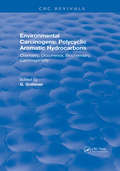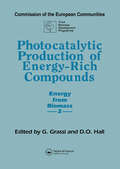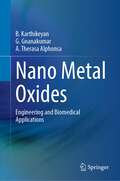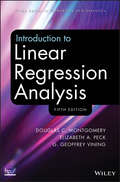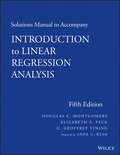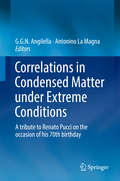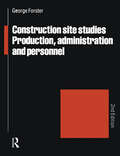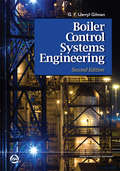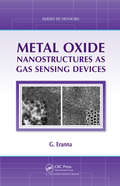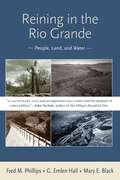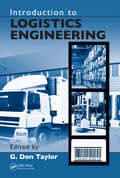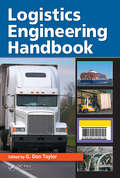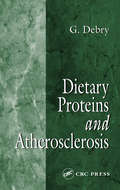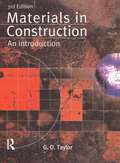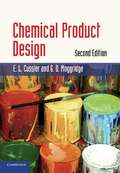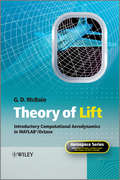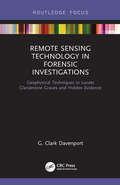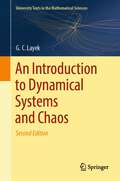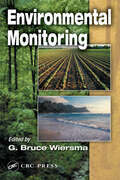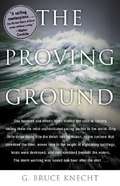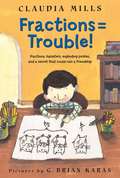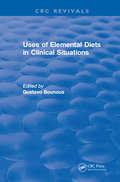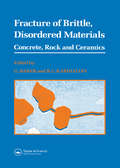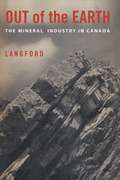- Table View
- List View
Environmental Carcinogens: Polycyclic Aromatic Hydrocarbons
by G. GrimmerThe present survey comprises today‘s knowledge of environmental pollution in particular of the atmosphere by PAH and of the biological effects of this class of substance, putting special emphasis on their carcinogenic activity. The research data and conclusions derived therefrom are meant to assist the government of the Federal Republic of Germany in determining an air quality standard.
Photocatalytic Production of Energy-Rich Compounds
by G. Grassi D.O. HallThis workshop comprises part of the four-year (1985-1988) non-nuclear energy R & D programme for the development of renewable energy sources which is being implemented by the Commission of the European Communities. The aim of the workshop was to present work by the contracting laboratories in addition to work by numerous other research laboratories
Nano Metal Oxides: Engineering and Biomedical Applications
by B. Karthikeyan G. Gnanakumar A. Therasa AlphonsaThis book highlights theoretical and experimental facts about selective nano-metal oxides. TiO2 ,ZnO and transition metal oxides which are known to be semiconductors and find applications in various fields. This book presents about recent findings like photo catalysis, sensing ,coating and biomedical applications. Therapeutic and future applications that are recently been reported of various metal oxides are presented in this book.
Introduction to Linear Regression Analysis
by Douglas C. Montgomery Elizabeth A. Peck G. Geoffrey ViningAs the Solutions Manual, this book is meant to accompany the main title, Introduction to Linear Regression Analysis, Fifth Edition. Clearly balancing theory with applications, this book describes both the conventional and less common uses of linear regression in the practical context of today's mathematical and scientific research. Beginning with a general introduction to regression modeling, including typical applications, the book then outlines a host of technical tools that form the linear regression analytical arsenal, including: basic inference procedures and introductory aspects of model adequacy checking; how transformations and weighted least squares can be used to resolve problems of model inadequacy; how to deal with influential observations; and polynomial regression models and their variations. The book also includes material on regression models with autocorrelated errors, bootstrapping regression estimates, classification and regression trees, and regression model validation.
Solutions Manual to accompany Introduction to Linear Regression Analysis (Wiley Series In Probability And Statistics Ser. #821)
by Douglas C. Montgomery Elizabeth A. Peck G. Geoffrey ViningAs the Solutions Manual, this book is meant to accompany the main title, Introduction to Linear Regression Analysis, Fifth Edition. Clearly balancing theory with applications, this book describes both the conventional and less common uses of linear regression in the practical context of today's mathematical and scientific research. Beginning with a general introduction to regression modeling, including typical applications, the book then outlines a host of technical tools that form the linear regression analytical arsenal, including: basic inference procedures and introductory aspects of model adequacy checking; how transformations and weighted least squares can be used to resolve problems of model inadequacy; how to deal with influential observations; and polynomial regression models and their variations. The book also includes material on regression models with autocorrelated errors, bootstrapping regression estimates, classification and regression trees, and regression model validation.
Correlations in Condensed Matter under Extreme Conditions: A tribute to Renato Pucci on the occasion of his 70th birthday
by Antonino La Magna G. G. AngilellaThis book addresses a wide range of topics relating to the properties and behavior of condensed matter under extreme conditions such as intense magnetic and electric fields, high pressures, heat and cold, and mechanical stresses. It is divided into four sections devoted to condensed matter theory, molecular chemistry, theoretical physics, and the philosophy and history of science. The main themes include electronic correlations in material systems under extreme pressure and temperature conditions, surface physics, the transport properties of low-dimensional electronic systems, applications of the density functional theory in molecular systems, and graphene. The book is the outcome of a workshop held at the University of Catania, Italy, in honor of Professor Renato Pucci on the occasion of his 70th birthday. It includes selected invited contributions from collaborators and co-authors of Professor Pucci during his long and successful career, as well as from other distinguished guest authors.
Construction Site Studies: Production Administration and Personnel
by G. ForsterThis book emphasises the practicalities of site supervision including the education and training of personnel and current legislation dealing with industrial relations, conditions of employment, health and welfare and first-aid regulations.Suitable for students studying for higher certificate/diploma, degree or professional examinations in building, site practice and construction management, this second edition will also be very useful reading for the practising site manager.
Boiler Control Systems Engineering
by G. F. Jerry GilmanThis book is for anyone who works with boilers: utilities managers, power plant managers, control systems engineers, maintenance technicians or operators. The information deals primarily with water tube boilers with Induced Draft (ID) and Forced Draft (FD) fan(s) or boilers containing only FD fans. It can also apply to any fuel-fired steam generator.
Metal Oxide Nanostructures as Gas Sensing Devices (ISSN)
by G. ErannaMetal Oxide Nanostructures as Gas Sensing Devices explores the development of an integrated micro gas sensor that is based on advanced metal oxide nanostructures and is compatible with modern semiconductor fabrication technology. This sensor can then be used to create a compact, low-power, handheld device for analyzing air ambience.The book first c
Reining in the Rio Grande: People, Land, and Water
by Fred M. Phillips G. Emlen Hall Black E. MaryThe Rio Grande was ancient long before the first humans reached its banks. These days, the highly regulated river looks nothing like it did to those early settlers. Alternately viewed as a valuable ecosystem and life-sustaining foundation of community welfare or a commodity to be engineered to yield maximum economic benefit, the Rio Grande has brought many advantages to those who live in its valley, but the benefits have come at a price.This study examines human interactions with the Rio Grande from prehistoric time to the present day and explores what possibilities remain for the desert river. From the perspectives of law, development, tradition, and geology, the authors weigh what has been gained and lost by reining in the Rio Grande.
Introduction to Logistics Engineering
by G. Don TaylorDespite its importance, logistics engineering often lags industry requirements, especially in terms of engineering-based needs. Filling the gap between education and practice, this brief but comprehensive volume covers the most basic material in the field of logistics engineering, making is suitable for those who require an overview of the topic. T
Logistics Engineering Handbook
by G. Don TaylorAchieving state-of-the-art excellence and attaining the cost reductions associated with outstanding logistics efforts is an obvious gain in terms of competitive edge and profitability. As logistics tools evolve in comprehensiveness and complexity, and the use of these new tools becomes more pervasive, maintaining a position of leadership in logisti
Dietary Proteins and Atherosclerosis
by G. DebryDietary Proteins and Atherosclerosis provides a thorough review of the role of proteins in the development of atherosclerosis. The author reviews early research connections between dietary fat and cardiovascular disease caused by the build-up of plaque in arteries and examines other factors that contribute to atherosclerosis, such as infection and
Materials in Construction: An Introduction (Chartered Institute Of Building Ser.)
by G. D. TaylorMaterials in Construction: An Introduction presents a clear and accessible introduction to the principles, practice and performance of construction materials. This new edition is being published as a companion to G. D. Taylor's Materials in Construction: Principles, Practice and Performance - an advanced text that will develop the topics presented in this book. The coverage of a wide range of construction materials provides a comprehensive foundation to the subject, and includes an overview of performance characteristics and standards for many materials. The text also reviews material properties, and examines and evaluates modes of deterioration while emphasising preventative techniques and remedial treatment. Throughout the text carefully devised example experiments and questions support the theory and practical information. Materials in Construction is an essential handbook for any student studying materials as part of a construction course at BTEC NC/D, HNC/D and undergraduate level.
Chemical Product Design
by E. L. Cussler G. D. MoggridgeThe chemical industry is changing, going beyond commodity chemicals to a palette of higher value added products. This groundbreaking book, now revised and expanded, documents this change and shows how to meet the challenges implied. Presenting a four-step design process – needs, ideas, selection, manufacture – the authors supply readers with a simple design template that can be applied to a wide variety of products. Four new chapters on commodities, devices, molecules/drugs and microstructures show how this template can be applied to products including oxygen for emphysema patients, pharmaceuticals like taxol, dietary supplements like lutein, and beverages which are more satisfying. For different groups of products the authors supply both strategies for design and summaries of relevant science. Economic analysis is expanded, emphasizing the importance of speed-to-market, selling ideas to investors and an expectation of limited time in the market. Extra examples, homework problems and a solutions manual are available.
Theory of Lift
by G. D. McbainStarting from a basic knowledge of mathematics and mechanics gained in standard foundation classes, Theory of Lift: Introductory Computational Aerodynamics in MATLAB/Octave takes the reader conceptually through from the fundamental mechanics of lift to the stage of actually being able to make practical calculations and predictions of the coefficient of lift for realistic wing profile and planform geometries.The classical framework and methods of aerodynamics are covered in detail and the reader is shown how they may be used to develop simple yet powerful MATLAB or Octave programs that accurately predict and visualise the dynamics of real wing shapes, using lumped vortex, panel, and vortex lattice methods.This book contains all the mathematical development and formulae required in standard incompressible aerodynamics as well as dozens of small but complete working programs which can be put to use immediately using either the popular MATLAB or free Octave computional modelling packages.Key features:Synthesizes the classical foundations of aerodynamics with hands-on computation, emphasizing interactivity and visualization.Includes complete source code for all programs, all listings having been tested for compatibility with both MATLAB and Octave.Companion website (www.wiley.com/go/mcbain) hosting codes and solutions.Theory of Lift: Introductory Computational Aerodynamics in MATLAB/Octave is an introductory text for graduate and senior undergraduate students on aeronautical and aerospace engineering courses and also forms a valuable reference for engineers and designers.
Remote Sensing Technology in Forensic Investigations: Geophysical Techniques to Locate Clandestine Graves and Hidden Evidence
by G. Clark DavenportRemote Sensing Technology in Forensic Investigations provides a basic understanding of concepts involved in the use of basic geophysical surveying, metal detectors, magnetics, electromagnetics and ground penetrating radar in police and forensic investigations. Such technology can be vital in locating clandestine, buried evidence which is often concealed in the subsurface underground. Crime scene investigation and evidence collection entails locating, identifying, collecting, and cataloging. Such physical evidence searches are time consuming and can often lead to searches that require excavations, which in itself that can destroy evidence. The noninvasive, nondestructive methods outlined in this book can both reduce the time spent on searches and excavations, thereby increasing the probability of locating vital physical evidence. As such, the application of remote sensing methods has gained increased acceptance, and seen increased usage, by investigators. Remote sensing methods are based on making indirect measurements of the surface of and within the earth. The resulting measurement information can be presented in either an imaging format— such as in aerial photography—or a non-imaging format, such as in a profile or contour map. These measurements can be interpreted to identify and characterize contrasts due to differences in physical and natural properties of the materials being studied. This can include physical evidence, remains, and clandestine graves. This book will serve as a handy introductory primer to the technology, techniques, and application of such techniques. Throughout, numerous references and additional resources are provided for those investigators, forensic anthropology, and police professionals who want further information on the technology’s usage for investigative purposes.
An Introduction to Dynamical Systems and Chaos (University Texts in the Mathematical Sciences)
by G. C. LayekThis book discusses continuous and discrete nonlinear systems in systematic and sequential approaches. The unique feature of the book is its mathematical theories on flow bifurcations, nonlinear oscillations, Lie symmetry analysis of nonlinear systems, chaos theory, routes to chaos and multistable coexisting attractors. The logically structured content and sequential orientation provide readers with a global overview of the topic. A systematic mathematical approach has been adopted, featuring a multitude of detailed worked-out examples alongside comprehensive exercises. The book is useful for courses in dynamical systems and chaos and nonlinear dynamics for advanced undergraduate, graduate and research students in mathematics, physics and engineering. The second edition of the book is thoroughly revised and includes several new topics: center manifold reduction, quasi-periodic oscillations, Bogdanov–Takens, period-bubbling and Neimark–Sacker bifurcations, and dynamics on circle. The organized structures in bi-parameter plane for transitional and chaotic regimes are new active research interest and explored thoroughly. The connections of complex chaotic attractors with fractals cascades are explored in many physical systems. Chaotic attractors may attain multiple scaling factors and show scale invariance property. Finally, the ideas of multifractals and global spectrum for quantifying inhomogeneous chaotic attractors are discussed.
Environmental Monitoring
by G. Bruce WiersmaThe current rate and scale of environmental change around the world makes the detection and understanding of these changes increasingly urgent. Subsequently, government legislation is focusing on measurable results of environmental programs, requiring researchers to employ effective and efficient methods for acquiring high-quality data. Focusing on pollution issues and impacts resulting from human activities, Environmental Monitoring is the first to bring together the conceptual basis behind the complex and specific approaches to the monitoring of air, water, and land. Coverage includes integrated monitoring at the landscape level, as well as case studies of existing monitoring programs such as the Chesapeake Bay Program. The book also addresses the recent legislative focus on high-quality data results and conducting monitoring programs in different ecosystems and environmental media.
The Proving Ground: The Inside Story of the 1998 Sydney to Hobart Race
by G. Bruce KnechtThe story of one of the worst disasters in modern yachting history. 115 boats that started under clear skies in Sydney, just 43 would finish...after the fleet had been ripped apart by unforecast winds and 80-foot-high waves.
Fractions = Trouble!
by Claudia Mills G. Brian KarasIf Wilson Williams thought multiplication was difficult, he is finding fractions impossible. And when his parents hire a math tutor for him, he is sure he's the only kid in the history of Hill Elementary to have one. Wilson is determined to make sure that no one finds out, not even his best friend, Josh. At least his pet hamster, Pip, is sympathetic. Pip is going to be part of Wilson's science fair project, because any project with hamsters in it is bound to be wonderful. But Josh has the coolest project of all: at what temperature does a pickle explode? Unfortunately, it looks as if Wilson's secret may end up exploding their friendship. Claudia Mills' Fractions = Trouble is a fun and thoroughly relatable story that Kirkus Reviews calls an "excellent selection for early chapter-book readers. "
Uses of Elemental Diets in Clinical Situations
by G. BounousThe studies presented in this book demonstrate that a new concept in the management of carious intestinal disorders should be considered, namely, that common nutrients may protect or heal the mucosa by virtue of the particular form and mode in which they are delivered to the intestinal lumen and their availability to the mucosal cells. The substitution of intact protein in the formula by hydrolysate appears to me an important factor.
Fracture of Brittle Disordered Materials: Concrete, Rock and Ceramics
by B. L. Karihaloo G. BakerThis book derives from the invited IUTAM Symposium in September 1993. The contributions discuss recent advances in fracture mechanics studies of concrete, rock, ceramics and other brittle disordered materials at micro and structural levels. It draws together research and new applications in continuum, damage and fracture mechanics approaches.
Out of the Earth: The Mineral Industry in Canada
by G. B. Langford<p>OUT of the Canadian earth come treasures right and rare--gold, silver, uranium. Out of the earth come the raw materials of the industry--iron,copper, nickel, and the like. From deep in the earth flows the petroleum that keeps the wheels moving in our modern economy. Coal for our fires lies under the soil of Canadian prairies, mountains, and coastal seas. From the earth comes the building materials for towns and cities, roads, and bridges. From the earth come the glass and dishes for our homes, the salt for our tables, and the nylons we wear. Every Canadian uses the products of our mines. Many persons are employed in the mining industry, or in the multitude of industries dependent on its products. Many Canadians are investors in the industry, buying shares in mining companies, or processing industries, or the enterprises that sell mineral products to the public. <p>This book is the direct result of the desire expressed by Canadians in many walks ofl ife to know "more about mining." It takes the interested layman on a short trip through the complex mining industry. It describes, very clearly and readably, how the minerals were formed int he earth, how they are found, how they are taken out of the earth, and how the ores are processed and the petroleum transformed to high grade gasoline. It goes farther, telling how a mine is financed, how the prospector, the engineer, the government, the mine operator, financier, and investor combine to make the great Canadian mineral industry what it is. It tells, too, about the "jobs" in the industry--about the opportunities for geologists, geophysicists, engineers, production and physical metallurgists, and many other professions that young Canadians find both challenging and rewarding. This book gives the clue to the "language" of the mining industry--"conglomerate," "stope," "spudding in," "repressuring," "working option," "reorganization," "speculative risk"--to name only a few terms that are read on the financial page every day, and which the intelligent investory wants to understand clearly. <p>Out of the Earth tells about mining as it is today. We meet not just the propector carrying his pick, but the airborne magenetometer, which detects mineral deposits from the sky. Most readers have heard of the use of Geiger counters in locating radioactive substances, but here we read also, for example, about the seismic methods of mineral exploration, by which dynamite is fired in the earth and the shock-wave patterns calculated on instruments.Helping to make important points of the story clear are simple tables and 40 excellent line-drawings and charts. A group of photographs, chosen for informational value as well as pictorial interest, is included.</p>
Introduction to Structural Dynamics and Aeroelasticity
by Dewey H. Hodges G. Alvin PierceThis text provides an introduction to structural dynamics and aeroelasticity, with an emphasis on conventional aircraft. The primary areas considered are structural dynamics, static aeroelasticity, and dynamic aeroelasticity. The structural dynamics material emphasizes vibration, the modal representation, and dynamic response. Aeroelastic phenomena discussed include divergence, aileron reversal, airload redistribution, unsteady aerodynamics, flutter, and elastic tailoring. More than one hundred illustrations and tables help clarify the text, and more than fifty problems enhance student learning. This text meets the need for an up-to-date treatment of structural dynamics and aeroelasticity for advanced undergraduate or beginning graduate aerospace engineering students. Praise from the First Edition "Wonderfully written and full of vital information by two unequalled experts on the subject, this text meets the need for an up-to-date treatment of structural dynamics and aeroelasticity for advanced undergraduate or beginning graduate aerospace engineering students. " - Current Engineering Practice "Hodges and Pierce have written this significant publication to fill an important gap in aeronautical engineering education. Highly recommended. " - Choice ". . . a welcome addition to the textbooks available to those with interest in aeroelasticity. . . . As a textbook, it serves as an excellent resource for advanced undergraduate and entry-level graduate courses in aeroelasticity. . . . Furthermore, practicing engineers interested in a background in aeroelasticity will find the text to be a friendly primer. " - AIAA Bulletin
